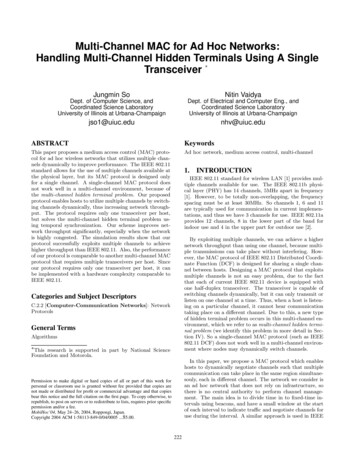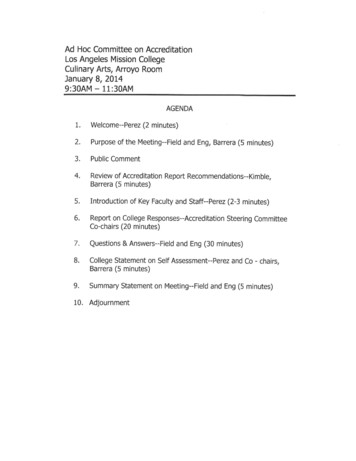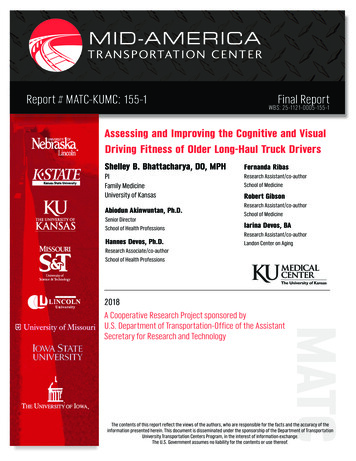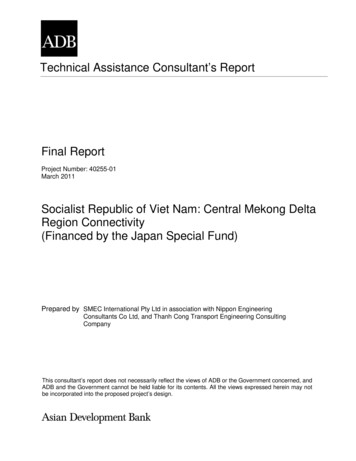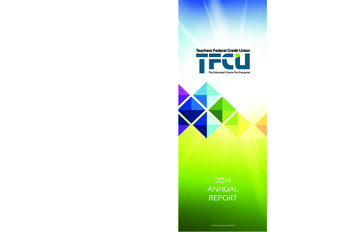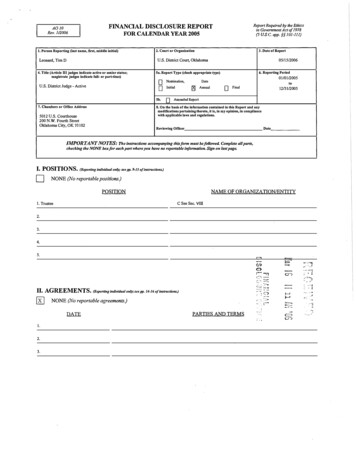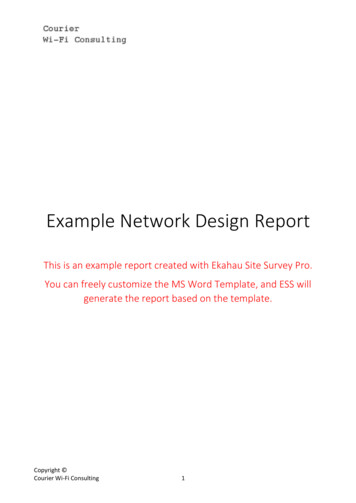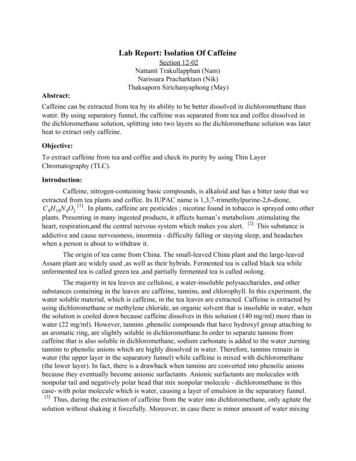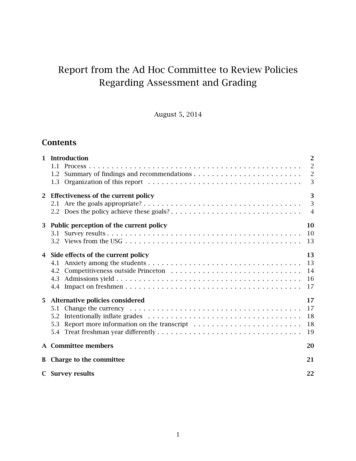
Transcription
Report from the Ad Hoc Committee to Review PoliciesRegarding Assessment and GradingAugust 5, 2014Contents1 Introduction1.1 Process . . . . . . . . . . . . . . . . . . . . . . . . . . . . . . . . . . . . . . . . . . . . . . .1.2 Summary of findings and recommendations . . . . . . . . . . . . . . . . . . . . . . . .1.3 Organization of this report . . . . . . . . . . . . . . . . . . . . . . . . . . . . . . . . . .22232 Effectiveness of the current policy2.1 Are the goals appropriate? . . . . . . . . . . . . . . . . . . . . . . . . . . . . . . . . . . .2.2 Does the policy achieve these goals? . . . . . . . . . . . . . . . . . . . . . . . . . . . . .3343 Public perception of the current policy3.1 Survey results . . . . . . . . . . . . . . . . . . . . . . . . . . . . . . . . . . . . . . . . . . .3.2 Views from the USG . . . . . . . . . . . . . . . . . . . . . . . . . . . . . . . . . . . . . . .1010134 Side effects of the current policy4.1 Anxiety among the students . . . . .4.2 Competitiveness outside Princeton4.3 Admissions yield . . . . . . . . . . . .4.4 Impact on freshmen . . . . . . . . . .1313141617.1717181819.5 Alternative policies considered5.1 Change the currency . . . . . . . . . . . . . .5.2 Intentionally inflate grades . . . . . . . . . .5.3 Report more information on the transcript5.4 Treat freshman year differently . . . . . . . .A Committee members20B Charge to the committee21C Survey results221
1IntroductionIn April 2004, the faculty adopted a grading policy that aimed to provide common gradingstandards across academic departments and to give students clear signals from their teachersabout the difference between good work and their very best work. The policy recommendedthat, over time, each department award no more than 35% of A-range grades for course workand no more than 55% of A-range grades for junior and senior independent work.In October 2013, President Eisgruber charged an ad hoc faculty committee with reviewingthe University’s policies for how student work is evaluated. The committee was composed offaculty members from each division and included current or past members of the Committeeon Grading and the Committee on Examinations and Standing, as well as faculty who regularlyteach large numbers of undergraduates. The members of the ad hoc committee are listed inAppendix A.The president asked the members of the committee to explore whether the grading policy’sobjectives remain the appropriate ones against which to judge Princeton’s assessment practices. He also asked them to examine whether the policy achieves the University’s pedagogicalgoals effectively, with as few negative consequences as possible, or whether there are betterways to reach those goals. The president’s charge to the ad hoc committee is attached to thisreport as Appendix B.1.1ProcessIn the course of its work, the committee sought broad input. We surveyed current faculty members and undergraduates, created a public comment website to elicit feedback from alumni andparents, and met with a range of administrators, faculty members, and students to discusstheir perspectives on and experiences under the grading policy. In addition, the committee analyzed existing quantitative and qualitative data and consulted with colleagues at select peerinstitutions to better understand their policies and practices with regard to grading.1.2Summary of findings and recommendationsBased on what we learned, we recommend a number of changes to the current policy, whichwe summarize here.Remove the numerical targets from the grading policy. Such targets are too often misinterpreted as quotas. They add a large element of stress to students’ lives, making them feel asthough they are competing for a limited resource of A grades.Charge departments with developing their own grading standards. We recommend replacing the numerical guidelines with a set of grading standards developed and articulated byeach department. These standards, which could be reported to the dean of the college as wasrecently done with standards for independent work, would help meet the goal of the currentpolicy of maintaining “consistent standards across departments.” Note that while “consistentstandards” has been interpreted to mean “consistent grades,” standards are not the same asgrades, as we discuss in Section 2.1. Indeed, it is difficult even to define how to compare the“standards” among departments in vastly different fields. Furthermore, the data discussedin Section 2.2 show that the grading policy has had limited success at improving consistency2
of grades across departments, and in some cases has made the disparity worse (for instance,between students concentrating in Engineering as opposed to Mathematics or Physics).As we show in Section 2.2, grades began to decline a year before the grading policy wasput in place. A reasonable interpretation is that this decline was due to conversations thedean of the college was having with departments about grade inflation, which resulted in anincrease in general awareness of grading policy among the faculty. We recommend that thedean of the college continue to monitor grades across departments and communicate withdepartments when their own grading policies appear to be changing over time. We furtherrecommend that departments internally review their grading history on a regular basis toensure consistency with their own promulgated grading standards. We suggest that this sort ofcontinuing conversation is a more effective and positive way of having an appropriate gradingpolicy, and with fewer undesirable side effects, than setting numerical targets.Dissolve the Committee on Grading. The emphasis should move away from “grades,” andinstead focus on “quality of feedback.” To this end, we feel it would be appropriate to chargethe newly-formed Council on Teaching and Learning with advancing efforts to improve qualityof feedback, in place of the Committee on Grading’s current focus on limiting grade inflation.No changes to the freshman year. While not part of our formal charge, we were also asked toexamine whether grading in freshman year ought to be treated differently in order to help easethe transition to Princeton. After careful consideration, we do not recommend any changesto the grading in freshman year. As discussed in Section 5.4, we considered many possiblescenarios, including covered grades, or no grades, for a semester or a year, and we think thatall of these have the potential to create more problems than they solve. We do note thatfreshman year (especially the first semester) is a stressful time for students, particularly forfirst-generation college students and those from disadvantaged backgrounds. However, we arenot convinced that grades are the central issue here. In order to address this issue, some othergroup could be convened to focus exclusively on freshman year and to consider more thanjust grades.1.3Organization of this reportThe remainder of this report details the process and analysis we went through to reach ourconclusions. In Section 2, we discuss whether the goals of the current policy are the appropriate ones and whether the policy has been effective in meeting those goals. In Section 3, welook at the public perception of the policy, discussing the results of the surveys mentionedabove. Next, in Section 4, we discuss our understanding of the main side effects of the policy.We then briefly describe, in Section 5, some alternative policies we considered but did not endup recommending.22.1Effectiveness of the current policyAre the goals appropriate?The current grading policy has two main objectives: a) to maintain “fair and consistent” grading standards across academic departments; and b) to give students clear signals about the3
quality of their work. We were concerned throughout our discussions to determine whetherthese goals are appropriate.Our findings suggest that the first goal is not appropriate. In our online surveys, to bediscussed in more detail in Section 3.1, a majority of both students (68%) and faculty (60%)who responded agree or strongly agree that “Students in one academic department shouldbe graded according to the same standards as students in any other department.” But only5% of students and only 6% of faculty actually believe the current policy is effective in meeting that objective. (Another 19% of students, and another 32% of faculty, believe the policyis “somewhat effective.”) In our view, this disparity arises because “consistent standards” isoften interpreted, by students and instructors alike, to mean “consistent grades”—an understandable misconception given the emphasis in the current policy on maintaining (in effect,standardizing) specific percentages of A-range grades.But standards are not the same as grades. Standards are the evaluative rubrics departmentsand instructors develop to convey to students the specific expectations for their work andagainst which that work will be graded. Grades measure the extent to which students meetthose expectations. “Consistent standards” is an admirable goal in the abstract, but in practiceit is our judgment that it is difficult if not impossible to compare standards across departmentsin different fields. Meaningful standards are—or should be—not only detailed but also highlycourse- and discipline-specific. They can only be easily compared across disparate fields ifthey are vague or generic. As a consequence it also seems to us less important that the samepercentage of students in every department receive A-range grades—the current implicationof the “consistent standards” objective—than that there be a high correlation between thegrades students receive and the evaluative rubrics in the specific courses they take. Thus wehave come to feel strongly that departments should spend their time developing clear andmeaningful evaluative rubrics for work within their disciplines rather than aligning grades tomeet specific numeric targets.Our findings suggest, on the other hand, that the second objective of the current gradingpolicy is appropriate: faculty should use grades to give students clear feedback about thequality of their work. This objective strikes us as integral to any grading policy. The onlinesurvey results affirm this belief: 79% of students and 93% of faculty who completed the surveyagree or strongly agree that “Grades should give clear signals about the difference betweenordinarily good work and the very best work.” At the same time, we do not believe that gradesare the only means, or even necessarily the most effective means, of giving such feedback.Instead it is the quality and content of instructor feedback—how detailed, informative, andtimely it is—that matters most and that should receive the highest emphasis in any gradingpolicy.2.2Does the policy achieve these goals?We begin with a summary of the history of grades at Princeton that led to the current policy,and of the experience since the current policy was implemented. The analyses below rely ondata provided by the registrar on the course-specific distribution of grades at Princeton fromacademic years 1974–2013. It does not include information on grades in junior and seniorindependent work.4
3.4050%3.3545%Fraction A grades3.30GPA3.253.203.153.1040%35%30%3.053.001975 1980 1985 1990 1995 2000 2005 2010 2015Academic year25% 1975 1980 1985 1990 1995 2000 2005 2010 2015Academic yearFigure 1: Average GPA and fraction A-range grades by year, 1974–2013.Average GPA and the fraction of A-range gradesThe left panel of Figure 1 shows the average GPA at Princeton each academic year from 1974to 2013; the right panel shows the fraction of grades at Princeton in the A range (A , A, A )each year over the same period. Several interesting features are apparent from these figures: There was substantial grade inflation from 1974 through 2003. Over this period, the rawaverage grade at Princeton increased from 3.03 (B) to 3.38 (above B ). Over the sameperiod, the fraction of grades in the A range increased from 29.9% to 47.9%. Indeed, itwas recognition of this trend that resulted in the adoption of the current grading policyin 2004 (effective for the 2005 academic year). GPA peaked in the 2002 academic year and subsequently fell sharply through 2005, anticipating by two years the application of the current grading policy. While the drop inGPA in 2003 is influenced by a change in the way Pass/Fail grades were recorded (see thediscussion of Figure 2 below), both the average GPA and the fraction of A-range gradesdeclined further in 2004, a year before the present grading policy was adopted. GPA increased somewhat after 2006, by 0.05 GPA points. The fraction of A-range gradescontinued to decrease a bit for a few years after 2005, but between 2009 and 2013, thefraction increased by 3.3 percentage points. These recent increases may reflect a changein monitoring the current policy.The timing of the decline in average GPA and the fraction of A-range grades suggests thatthe implementation of the current grading policy was only partially responsible for arresting the increase in grades that had occurred over the previous quarter century. However, asoutlined above, the timing does suggest a potentially important alternative understanding thathelped guide us in formulating our recommendations. The decline in average GPA and the fraction of A-range grades began at about the time a vigorous debate started among the facultyregarding grading, grade inflation, and a potential change in grading policy. This discussionwas precipitated by interest from the dean of the college in the issue, and ultimately resultedin the 2004 grading policy with numerical targets for the fraction of A-range grades. What the5
50%25%20%30%A /A
Figure 1: Average GPA and fraction A-range grades by year, 1974–2013. Average GPA and the fraction of A-range grades The left panel of Figure 1 shows the average GPA at Princeton each academic year from 1974 to 2013; the right panel shows the fraction of grades at Princeton in the A range (A , A, A) each year over the same period. Several interesting features are apparent from these figures:
